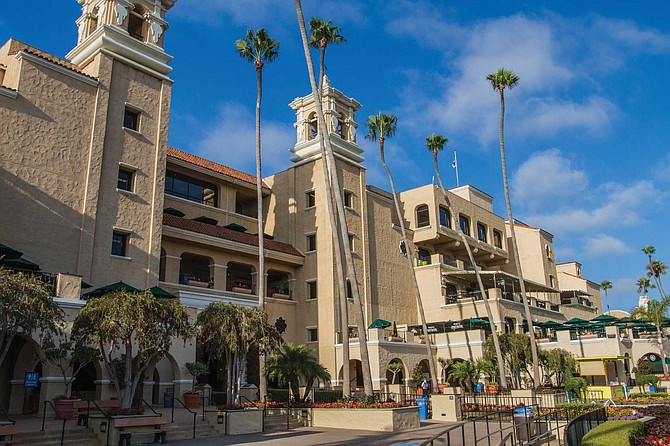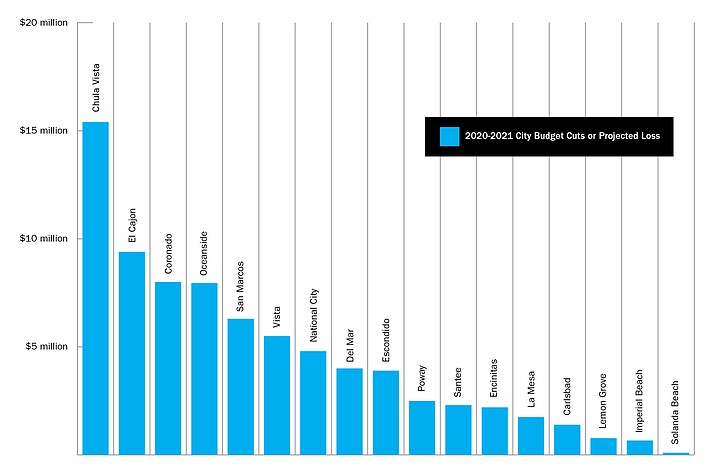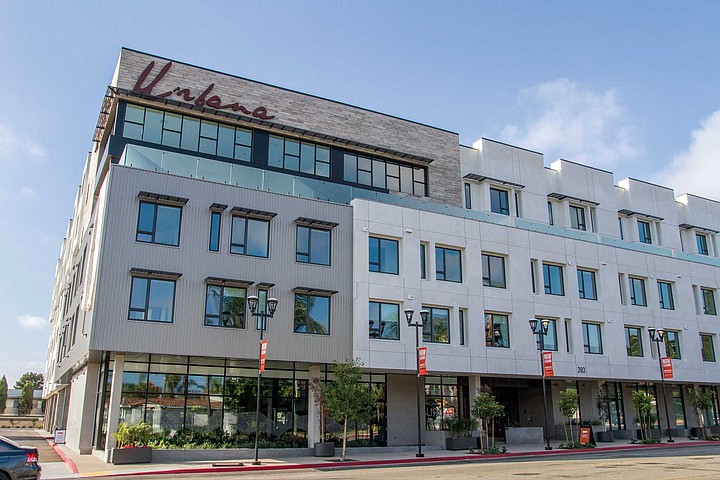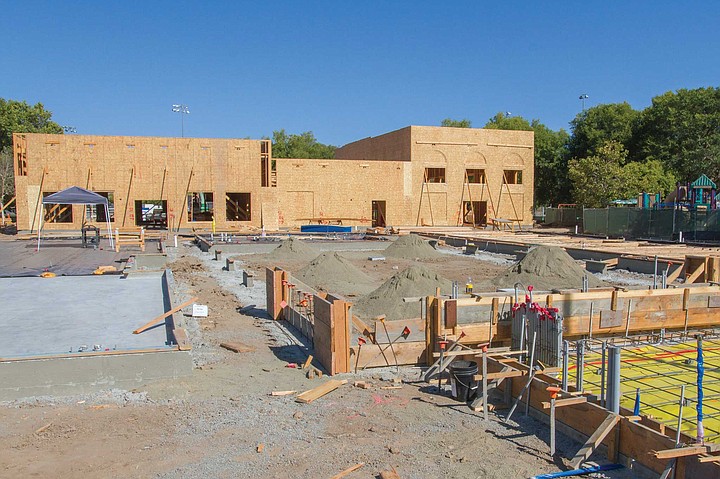 Facebook
Facebook
 X
X
 Instagram
Instagram
 TikTok
TikTok
 Youtube
Youtube

San Marcos City Manager Jack Griffin begins his annual June letter to the mayor and city council, “It is kind of my pleasure to submit the Fiscal Year 2020-2021 Operations and Maintenance Budget.” That “kind of” summarizes the sour monetary mood facing San Diego’s 17 county cities and their managers in the new pandemic normal. The economic pain of dwindling revenue varies by city and its relative affluence, but losses are universal. Since March, taxes on hotels, entertainment, bars and restaurants, car sales, and pot shops — typically about a third of a city’s spending base, collectively — have fallen and, as people remain largely at home, will continue to fall. As a result, most previously funded departments and staff, though spared, are being pared: social services snipped, capital projects deferred, full- and part-time workers furloughed or laid off, new hires frozen, libraries closed, recreation programs reduced, street repairs delayed, and parks dark. No municipality can cut salaries and benefits for firefighters and police; cities are contractually bound.

The fiscal year generally runs from July 1 to June 30. Budgets are not set in stone. They are subject to the vicissitudes of collection, that is, a city’s annual expenditure is as much mandated as it is projected: X dollars must come in to pay for Y services.

The capsule summaries of 17 city budgets below tally their 2020-2021 expenses, each belt tightened, each forecast trimmed. The figure for cuts shows what’s already been made while the figure for losses is projected. Many cities have reserves to bail them out, at least, for the coming year. Those with lean stashes and rising costs suffer more.
Carlsbad
Budget: $287.4 million
Cuts: $1.4 million
Fourth in county population (112,000) behind San Diego (1.4 million), Chula Vista (272,000), and Oceanside (174,000), Carlsbad is sitting rather pretty on a little Fort Knox of reserves. Several years of robust tourism — Legoland, flower fields, car dealers — and increasing property values have fattened the reserves to $88.9 million. (Note: generally, the county’s seaside cities, obvious vacation meccas, fly higher and fall harder if they don’t have a well-stocked pantry.) Fewer funds from “affordable housing revenues and donations” will lower revenues. The city manager writes in the budget summary that Carlsbad was on pace to have its best monetary year ever. “The impacts of the COVID-19 have drastically impacted sales tax, transient occupancy tax, income from property and investments, and other revenues.” And yet a cut of $1.4 million hardly sounds drastic for what seems one of the best positioned communities in the county.

Chula Vista
Budget: $405.7 million
Cuts: $15.4 million (TBD)
This 52-square-mile palms-to-pines city — home to some 65 parks, a fine old California downtown, and a 61 percent Latino population — has been a homebuilder’s delight. In the last decade, the explosive growth has been concentrated in sprawling developments — Eastlake, Rancho del Rey, and Otay Ranch. There’s lots of land and landscape in Chula Vista, but it’s getting packed, though not yet sardine-canned like Mission Valley.
The 2020-2021 budget was passed before the coronavirus costs were factored in: “Job losses, business closures, and related financial impacts will reduce revenues,” reads the fiscal-year report. The same report states that the pre-Covid estimate was $15.4 million more than last year. It’s likely the projected cuts will return to the 2019’s level, less $15.4 million than what’s currently projected. The city could either (or both) siphon that sum from its reserves or defund 53.5 administrative positions Chula Vista wanted to add this coming year.
Coronado
Budget: $53 million
Losses: $8 million

A precipitous drop in annual funding is slated for Coronado: from $61 million (fiscal year beginning July 1, 2019), to $53 million (July 1, 2020), to $48.9 million (July 1, 2021) a near 20 percent slide of $12 million in two years. City Manager Blair King calls the current squeeze “The Ugly.” And yet, note his sunny forecast: “Yes, these are interesting times. While we did not expect a pandemic, we have long prepared for a recession and hard economic times.”
Where will King and Co. find scarce cash, as its 1913 hotel rooms are largely empty this summer? The promise, as outlined in the Budget Brief, notes the city will rely on reserves and “subordinate funds,” which are more than adequate. Despite taxes on tourists and sales tumbling more than 60 percent, taxes on Coronado’s sky-high properties will rise 4 percent to $34 million in revenue going forward, a healthy dose of do-re-mi, good times or bad.
Del Mar
Budget: $25.7 million
Cuts: $4 million
This two-square-mile tiny town, bounded by ocean, lagoon, and freeway, relies heavily on taxes from boutique hotels and entertainment venues. Chief of the latter is the Del Mar Fairgrounds. Without the Fair, fans for horse races, and myriad expositions, the venue expects to lose 92 percent of its yearly income. More than half of the Fairgrounds’ workers are facing layoffs or farewell (no golden parachutes, apparently). Tax losses from this one source will accumulate. The city council, citing the “extreme financial crisis,” cut 10 percent of city salaries via layoffs and furloughs. The plan to rid the town of unsightly utility poles and overhead wires, budgeted by Measure Q, has been tabled. The knife also sliced out $1.5 million for “operating costs, capital improvements, and special projects.” (In June, a councilmember predicted it would take at least two years “to get out of this hole.”) One bit of good news is that San Diego Association of Governments will pony up $66 million to stabilize the tracks along the eroding coastal bluffs — the well-worn route for Amtrak, the Coaster, and freight trains. Yet if riders quit jiggling up to Los Angeles and back or down to San Diego and back for work and whatnot, all those repairs, while necessary, will serve a ghost express. Good thing the fixup is classified critical infrastructure.
El Cajon
Budget: $74.1 million
Losses: $9.4 million

The title of El Cajon’s latest revenue report speaks to just how squishy budget projections can be: Preliminary Annual Budget Summary, a.k.a., “we’re not sure what’s happening.” City Manager Graham Mitchell writes that compared to last year, “the City has experienced a significant change in local economic conditions.” To even the keel, El Cajon is drawing $3.6 million out of its $41.7 million reserve fund. (That reserve, healthier than most cities, exists for “an economic or natural disaster.” Many cities mandate reserves: if the worst happens, they’re on their own. Deficit spending is not allowed, and no feds in white hats are riding in.) Projected revenue boosters include new car dealerships (Honda, BMW, Mercedes-Benz), plus nearly $40 million in already appropriated funds to revitalize the transit center and improve the infrastructure on Main Street and El Cajon Boulevard. Of all the budget reports I’ve read, El Cajon’s seems the most aspirational — many of its conclusions suggest a city that still thinks itself affordable despite San Diego County’s overpriced housing and sparse selection.

Encinitas
Budget: $71.2 million
Losses: $2.2 million
Encinitas, an amalgam of six towns, bordered by six miles of splendid beach, budgets on a two-year fiscal cycle; this is the second year of what’s already been appropriate. It includes a modest pandemic-related revision, a projected loss of $2.2 million. Like other seaside communities, Encinitas receives 67 percent of its annual revenue from property taxes, the most silver of linings. The safe bet is most homeowners will pay what they owe.
One of the city’s projects is an undercrossing (under the railroad tracks) between Highway 101 and Vulcan Avenue in Leucadia. Despite a strong citizen coalition to build it, the budgeters broke many a heart when they voted the venture “unfunded” this June. Garbage collection is costing more, and the excess will help buy a new sprinkler system, carpeting, chairs, and a paint job at city hall, improvements already delayed for decades. Parks and police expenditures have escaped the ax.
Escondido
Budget: $114.1 million
Losses: $3.9 million
Alas, the one thing most county residents are loath to add is more sales tax. The city of Escondido, to reduce a projected punishing deficit, wants its citizens to vote on a one-cent sales tax in November, which would beef up the city’s coffers during the current downturn. How much it will help is unknown. A third of the general fund is for city services; 85 percent of that outlay is for personnel. All municipalities are top-heavy in paying salaries and pensions; most communities are loath to arbitrarily cut wages. It usually leads to a revolt, a slowdown, and a demoralized workforce. In the Budget Brief, the city declares that “annual projected deficits were to grow to $14 million by fiscal year 2023-24 and were to continue over the next 15 years.”
Note the past tense: “were.” That was before things got complicated. Translation: Escondido will run a $7 million deficit for the next two years, and $7 million every year after that until 2038. Such dire losses might be less withering with a 1-cent sales tax and the return of sales and franchise taxes to their pre-Covid range, given a revitalized U.S economy. But an ongoing financial crisis may mean cuts or losses (choose your poison) for years to come in the county’s “City of Choice!”
Imperial Beach
Budget: $20.8 million
Cuts: $667,000
Here’s one city that announces in its current budget summary its top priority: “to live within its means.” It’s nice to hear some humility. IB is a town almost invisible to the big butch berg of San Diego to the north. But IB buffers environmentally the southern reach of the county with its proximity to the border, the Tijuana River, and the South Bay tidelands. Maybe its unknown charm is fading, as the city has instituted high percentage increases for property taxes and building fees. Still, the town of 27,447 is “experiencing extraordinary fiscal impacts.” Their pension debt is $12 million, and the town owes $850,000 to the Sheriff’s department. (In the past decade, county cities in the South Bay have seen police and fire department costs rise from 40 to 65 percent of their budgets.) Because the city works on a two-year cycle (2019-2021), the effects of the current mess are not reflected in its budget summary. Emails and calls have gone unanswered. Seems city hall has furloughed itself.
La Mesa
Budget: $53 million
Losses: $1.75 million
La Mesa, which budgets every two years, held emergency council meetings after George Floyd-related protests and a revised mid-biennium update to their expenses. Police, fire, salaries, and pensions account for 80 percent of expenditures. The council signed off on more pandemic-related losses totaling $1.75 million. It’s also necessary to withdraw $5.1 million from the city’s $27.8 million reserves, a steep 58 percent rise over the reserve withdrawal last year. In 2008, La Mesa residents passed a 20-year, three-quarters-of-a-cent sales tax; for city use only, it brings in 18 percent of the yearly revenue. One outlay, already received from community block grants, will help the health and safety of La Mesa’s homeless. According to the budget description, this means funds for “COVID-19 testing, diagnosis, treatment and/or other medical services; counseling; distribution of hygiene kits and personal protective equipment; meal and water delivery; housing navigation and case management; and supportive housing.”

Lemon Grove
Budget: $14.7 million
Cuts: $770,000
Lemon Grovers have never wallowed in the lap of luxury, and the enduring Latino settlement has been growing fiscally less sound, year by year, since incorporation in 1977. The pandemic has begun to snowball. Even with a $5.4 million reserve, the city’s finance director, Molly Brennan, says that if bad news keeps coming, that fund will disappear in two years. There is some talk of disincorporation, after which the county would become Lemon Grove’s caretaker. And the ax has fallen. One sheriff’s deputy, one sheriff’s department property and evidence specialist, 10 percent pay cuts for mayor and councilmembers, and a 25 percent reduction in street sweeping service. Oh yes, a hiring freeze, no paid-for city-related travel, no city-used auto expenses, no more graffiti removal, no emergency satellite phones, no trauma programs, and definitely no more firework fests unless they’re sponsored. The projected deficit for June 30, 2021, as of now, is $1.8 million. Locals rejected a sales tax hike this March. But the city council is asking voters to approve a tax on marijuana sales, adding $500,000 to $1 million a year. The welcome mat is out for other dispensaries to set up pot shops in Lemon Grove as well.
National City
Budget: $96.3 million
Cuts: $4.8 million

National City is a mecca for reasonable apartment rents. It’s also a good bet for tax revenues coming from its Mile of Cars. These days, however, the virus has slowed those funds considerably. According to City Manager Brad Raulston, National City is facing “significant revenue losses” of $4.8 million. Their fiscal year, based on the January-to-December calendar, shows 2020’s budget down to $93.1 million from 2019’s $96.3 million. What about 2021? The city is bulwarking itself against more losses by “avoiding hasty decisions that may affect core services and employee morale, opting to instead focus on short-term measures to cut expenditures, freeze positions, defer capital projects, and utilize reserves.”
Those frozen positions — an odd metaphor — are no doubt thawed out and staffed by current hires who are doing double duty, so I’m not so sure “employee morale” remains upbeat. The city is hoping for fiscal relief as are municipalities nationwide, mini budgetary handouts from Washington. Currently, it’s another package on which the House and Senate are unable to agree.
A sour note: coronavirus deaths countywide are highest in National City’s 91950 zip code.
Oceanside
Budget: $157.6 million
Cuts: $7.95 million
Comparing the budgets of 2019-2020 ($172.8 million) to the current fiscal year reveals a major loss: $15.2 million, one of the largest drops in the county. A closer examination suggests that the revenue to cover last year’s budget was less robust than expected, especially during the first half of 2020. Thus, the city remains on a slow bleed. With the city council mandating nearly $8 million in cuts, the following reductions must be made: personnel costs (a.k.a. “vacant funded positions,” which sounds like a hiring freeze) by $4.29 million, maintenance and operations by $2.1 million, and an obscure category called “internal service funds” by $1.34 million. What makes all this much dicier is that the city has few reserves. That piggy bank is ultralight at $610,000. Correction, the piggy has not been put in the bank: the sum is merely a projection, the evidence of things hoped for. But an economic rebound this year is likely a pure mirage.

Poway
Budget: $93.1 million
Cuts: $1.5 - $2.5 million
Poway is nicknamed “The City in the Country.” Half of its 40 square miles is designated open space. It declares in its budget that the “pandemic has created a shock to all levels of the United States economy.”

Not to worry; the city has a “Volatility Reserve,” 45 percent of its annual expenditures, for just such a shock. Poway officials see the pandemic making a “V,” or down-up recovery, over the next two years, mapping out scenarios from mild to severe. City Manager Chris Hazeltine writes, with some self-flattery, that, as “a lean organization,” Poway’s “departments [have] identified expenditure retrenchment techniques that didn’t threaten health and safety, reduce service levels, or eliminate existing staff.”
The same thorn in the hide of all county cities persists: increasing payouts to police, firefighters, salaries, pensions, and insurance premiums. Revenues in the last several years have fallen, not precipitously but with regularity. But no crisis, it seems, will stop Poway’s premiere capital project from opening in May 2021: the Mickey Cafagna Community Center, “a shared-use, multi-generational facility,” which “will bring the community together for years to come.” The center salutes Poway’s irrepressibly genial ex-mayor, real estate developer, and chief cheerleader, who died in 2009.
San Marcos
Budget: $75.6 million
Cuts: $6.3 million

Hit especially hard in the economic gut is San Marcos: its unemployment rate went from 3 percent to 30 percent in one year. Things will worsen if landlords — some of whose income is based on student rentals around Cal State San Marcos — must delay payment on their property taxes. City Manager Jack Griffin, a rare stylish writer of budgetary analysis, describes how everything changed “from an economy-crushing pandemic to a period of civil unrest that has not been seen in over 50 years,” March to June, 2020.
To balance the budget, San Marcos has cut “non-safety employees” pay by 10 percent, furloughed all part-time staff, and mothballed a clutch of vacant but needed positions. Messing with the work hours of their “safety employees,” Griffin writes, was “not viewed as a wise move at all.” The city maintains a hardy $47.4 million reserve, which will drop when one $6.6 million capital project, already grandfathered in for next year, comes due.
The sober Griffin reminds his beleaguered citizens that any restoration of the city’s mojo, especially with parks and recreation and part-time workers, will have to be “something approximating pre-pandemic levels. We may never get fully back to that level.”
Santee
Budget: $46.4 million
Cuts: $2.3 million
During the pandemic, citizens repudiated two local clowns, food-shopping in a Nazi mask and a KKK hood. “Hate Has No Home Here” one sign read in the ensuing car rally. The city managed last fiscal year to balance its budget: revenues ($45.4 million) exceeded expenditures ($44.8 million) and a reserve fund of $9 million kept leaks plugged. Suddenly, the coronavirus stormed in, and the walls started to shake — sales and property taxes will meet neither pension payouts nor the services of the County Sheriff’s Department. Here’s that rainy day. For the next 12 months, the city is about $4.7 million below its outlays for capital improvements. It’s also a whopping $40 million below the projection for 2021-2022, which, in budget meetings, evokes the dreaded D word: deferral. Nearly all part-time workers, most in recreation, have been furloughed or laid off. The good news is that firefighters got a 2.5 percent raise, and not one of the 51 is working remotely.
Solana Beach
Budget: $58 million
Cuts: $100,000
In a dense 272-page budget report, Solana Beach officials say their spending plan concocts its “revenue assumptions included in the revenue forecasts,” which means the budgeters assume they will be able to forecast having X dollars for the coming fiscal year. Perhaps the conjecture double-take reflects the muck all county cities are mired in this summer: the first wave of Covid is unrelenting on people, services, and funding. Unlike mask-less adolescents bunched on the boardwalk, city budgets can’t social-distance from their expenditures. Solana Beach, along with other seaside locales known for dining, entertainment, lodging, and housing, has seen its yearly revenues, pumped by scads of fees and taxes, rise steadily by 4 to 5 percent. Indeed, the Trump term has been lucrative for the city’s coffers: The five-year growth in property taxes alone has been 22 percent. Solana Beach, however, gets only 16 percent of every property-tax dollar. Thus, a million-dollar-home homeowner pays $10,676 (property tax, 1.06767 percent) and the city gets $1708. The implication: there must be many through-the-roof home values in this coastal El Dorado; the city’s $100,000 shortfall for the coming year is virtually zilch.
Vista
Budget: $85.4 million
Losses: $5.5 million
All mimsy among the avocado groves, Vista is budgeting $85.4 million, up nearly 3 percent from the previous fiscal year. Like most cities, two thirds of the money has been allocated to public safety, the fire department, and the county sheriff’s department — as it is every year. Expected revenue increases of $2.5 million, Vista predicted, would accrue from property and sale taxes. Once the virus hit, that word “expected” fell off the budgetary wagon. In June, according to Vista city manager, Patrick Johnson, “we unfortunately made cuts to our Recreation and Community Services budget since our Moonlight Amphitheatre, Wave Waterpark, and Recreation Center are not open.”
And yet, a silver lining: Johnson will access nearly $5.5 million from the city’s reserve funds, which has been “set aside over the years specifically for the next recession or economic downturn.” Vista’s reserve is 31 percent of the current budget, fairly deep at $26.4 million.


San Marcos City Manager Jack Griffin begins his annual June letter to the mayor and city council, “It is kind of my pleasure to submit the Fiscal Year 2020-2021 Operations and Maintenance Budget.” That “kind of” summarizes the sour monetary mood facing San Diego’s 17 county cities and their managers in the new pandemic normal. The economic pain of dwindling revenue varies by city and its relative affluence, but losses are universal. Since March, taxes on hotels, entertainment, bars and restaurants, car sales, and pot shops — typically about a third of a city’s spending base, collectively — have fallen and, as people remain largely at home, will continue to fall. As a result, most previously funded departments and staff, though spared, are being pared: social services snipped, capital projects deferred, full- and part-time workers furloughed or laid off, new hires frozen, libraries closed, recreation programs reduced, street repairs delayed, and parks dark. No municipality can cut salaries and benefits for firefighters and police; cities are contractually bound.

The fiscal year generally runs from July 1 to June 30. Budgets are not set in stone. They are subject to the vicissitudes of collection, that is, a city’s annual expenditure is as much mandated as it is projected: X dollars must come in to pay for Y services.

The capsule summaries of 17 city budgets below tally their 2020-2021 expenses, each belt tightened, each forecast trimmed. The figure for cuts shows what’s already been made while the figure for losses is projected. Many cities have reserves to bail them out, at least, for the coming year. Those with lean stashes and rising costs suffer more.
Carlsbad
Budget: $287.4 million
Cuts: $1.4 million
Fourth in county population (112,000) behind San Diego (1.4 million), Chula Vista (272,000), and Oceanside (174,000), Carlsbad is sitting rather pretty on a little Fort Knox of reserves. Several years of robust tourism — Legoland, flower fields, car dealers — and increasing property values have fattened the reserves to $88.9 million. (Note: generally, the county’s seaside cities, obvious vacation meccas, fly higher and fall harder if they don’t have a well-stocked pantry.) Fewer funds from “affordable housing revenues and donations” will lower revenues. The city manager writes in the budget summary that Carlsbad was on pace to have its best monetary year ever. “The impacts of the COVID-19 have drastically impacted sales tax, transient occupancy tax, income from property and investments, and other revenues.” And yet a cut of $1.4 million hardly sounds drastic for what seems one of the best positioned communities in the county.

Chula Vista
Budget: $405.7 million
Cuts: $15.4 million (TBD)
This 52-square-mile palms-to-pines city — home to some 65 parks, a fine old California downtown, and a 61 percent Latino population — has been a homebuilder’s delight. In the last decade, the explosive growth has been concentrated in sprawling developments — Eastlake, Rancho del Rey, and Otay Ranch. There’s lots of land and landscape in Chula Vista, but it’s getting packed, though not yet sardine-canned like Mission Valley.
The 2020-2021 budget was passed before the coronavirus costs were factored in: “Job losses, business closures, and related financial impacts will reduce revenues,” reads the fiscal-year report. The same report states that the pre-Covid estimate was $15.4 million more than last year. It’s likely the projected cuts will return to the 2019’s level, less $15.4 million than what’s currently projected. The city could either (or both) siphon that sum from its reserves or defund 53.5 administrative positions Chula Vista wanted to add this coming year.
Coronado
Budget: $53 million
Losses: $8 million

A precipitous drop in annual funding is slated for Coronado: from $61 million (fiscal year beginning July 1, 2019), to $53 million (July 1, 2020), to $48.9 million (July 1, 2021) a near 20 percent slide of $12 million in two years. City Manager Blair King calls the current squeeze “The Ugly.” And yet, note his sunny forecast: “Yes, these are interesting times. While we did not expect a pandemic, we have long prepared for a recession and hard economic times.”
Where will King and Co. find scarce cash, as its 1913 hotel rooms are largely empty this summer? The promise, as outlined in the Budget Brief, notes the city will rely on reserves and “subordinate funds,” which are more than adequate. Despite taxes on tourists and sales tumbling more than 60 percent, taxes on Coronado’s sky-high properties will rise 4 percent to $34 million in revenue going forward, a healthy dose of do-re-mi, good times or bad.
Del Mar
Budget: $25.7 million
Cuts: $4 million
This two-square-mile tiny town, bounded by ocean, lagoon, and freeway, relies heavily on taxes from boutique hotels and entertainment venues. Chief of the latter is the Del Mar Fairgrounds. Without the Fair, fans for horse races, and myriad expositions, the venue expects to lose 92 percent of its yearly income. More than half of the Fairgrounds’ workers are facing layoffs or farewell (no golden parachutes, apparently). Tax losses from this one source will accumulate. The city council, citing the “extreme financial crisis,” cut 10 percent of city salaries via layoffs and furloughs. The plan to rid the town of unsightly utility poles and overhead wires, budgeted by Measure Q, has been tabled. The knife also sliced out $1.5 million for “operating costs, capital improvements, and special projects.” (In June, a councilmember predicted it would take at least two years “to get out of this hole.”) One bit of good news is that San Diego Association of Governments will pony up $66 million to stabilize the tracks along the eroding coastal bluffs — the well-worn route for Amtrak, the Coaster, and freight trains. Yet if riders quit jiggling up to Los Angeles and back or down to San Diego and back for work and whatnot, all those repairs, while necessary, will serve a ghost express. Good thing the fixup is classified critical infrastructure.
El Cajon
Budget: $74.1 million
Losses: $9.4 million

The title of El Cajon’s latest revenue report speaks to just how squishy budget projections can be: Preliminary Annual Budget Summary, a.k.a., “we’re not sure what’s happening.” City Manager Graham Mitchell writes that compared to last year, “the City has experienced a significant change in local economic conditions.” To even the keel, El Cajon is drawing $3.6 million out of its $41.7 million reserve fund. (That reserve, healthier than most cities, exists for “an economic or natural disaster.” Many cities mandate reserves: if the worst happens, they’re on their own. Deficit spending is not allowed, and no feds in white hats are riding in.) Projected revenue boosters include new car dealerships (Honda, BMW, Mercedes-Benz), plus nearly $40 million in already appropriated funds to revitalize the transit center and improve the infrastructure on Main Street and El Cajon Boulevard. Of all the budget reports I’ve read, El Cajon’s seems the most aspirational — many of its conclusions suggest a city that still thinks itself affordable despite San Diego County’s overpriced housing and sparse selection.

Encinitas
Budget: $71.2 million
Losses: $2.2 million
Encinitas, an amalgam of six towns, bordered by six miles of splendid beach, budgets on a two-year fiscal cycle; this is the second year of what’s already been appropriate. It includes a modest pandemic-related revision, a projected loss of $2.2 million. Like other seaside communities, Encinitas receives 67 percent of its annual revenue from property taxes, the most silver of linings. The safe bet is most homeowners will pay what they owe.
One of the city’s projects is an undercrossing (under the railroad tracks) between Highway 101 and Vulcan Avenue in Leucadia. Despite a strong citizen coalition to build it, the budgeters broke many a heart when they voted the venture “unfunded” this June. Garbage collection is costing more, and the excess will help buy a new sprinkler system, carpeting, chairs, and a paint job at city hall, improvements already delayed for decades. Parks and police expenditures have escaped the ax.
Escondido
Budget: $114.1 million
Losses: $3.9 million
Alas, the one thing most county residents are loath to add is more sales tax. The city of Escondido, to reduce a projected punishing deficit, wants its citizens to vote on a one-cent sales tax in November, which would beef up the city’s coffers during the current downturn. How much it will help is unknown. A third of the general fund is for city services; 85 percent of that outlay is for personnel. All municipalities are top-heavy in paying salaries and pensions; most communities are loath to arbitrarily cut wages. It usually leads to a revolt, a slowdown, and a demoralized workforce. In the Budget Brief, the city declares that “annual projected deficits were to grow to $14 million by fiscal year 2023-24 and were to continue over the next 15 years.”
Note the past tense: “were.” That was before things got complicated. Translation: Escondido will run a $7 million deficit for the next two years, and $7 million every year after that until 2038. Such dire losses might be less withering with a 1-cent sales tax and the return of sales and franchise taxes to their pre-Covid range, given a revitalized U.S economy. But an ongoing financial crisis may mean cuts or losses (choose your poison) for years to come in the county’s “City of Choice!”
Imperial Beach
Budget: $20.8 million
Cuts: $667,000
Here’s one city that announces in its current budget summary its top priority: “to live within its means.” It’s nice to hear some humility. IB is a town almost invisible to the big butch berg of San Diego to the north. But IB buffers environmentally the southern reach of the county with its proximity to the border, the Tijuana River, and the South Bay tidelands. Maybe its unknown charm is fading, as the city has instituted high percentage increases for property taxes and building fees. Still, the town of 27,447 is “experiencing extraordinary fiscal impacts.” Their pension debt is $12 million, and the town owes $850,000 to the Sheriff’s department. (In the past decade, county cities in the South Bay have seen police and fire department costs rise from 40 to 65 percent of their budgets.) Because the city works on a two-year cycle (2019-2021), the effects of the current mess are not reflected in its budget summary. Emails and calls have gone unanswered. Seems city hall has furloughed itself.
La Mesa
Budget: $53 million
Losses: $1.75 million
La Mesa, which budgets every two years, held emergency council meetings after George Floyd-related protests and a revised mid-biennium update to their expenses. Police, fire, salaries, and pensions account for 80 percent of expenditures. The council signed off on more pandemic-related losses totaling $1.75 million. It’s also necessary to withdraw $5.1 million from the city’s $27.8 million reserves, a steep 58 percent rise over the reserve withdrawal last year. In 2008, La Mesa residents passed a 20-year, three-quarters-of-a-cent sales tax; for city use only, it brings in 18 percent of the yearly revenue. One outlay, already received from community block grants, will help the health and safety of La Mesa’s homeless. According to the budget description, this means funds for “COVID-19 testing, diagnosis, treatment and/or other medical services; counseling; distribution of hygiene kits and personal protective equipment; meal and water delivery; housing navigation and case management; and supportive housing.”

Lemon Grove
Budget: $14.7 million
Cuts: $770,000
Lemon Grovers have never wallowed in the lap of luxury, and the enduring Latino settlement has been growing fiscally less sound, year by year, since incorporation in 1977. The pandemic has begun to snowball. Even with a $5.4 million reserve, the city’s finance director, Molly Brennan, says that if bad news keeps coming, that fund will disappear in two years. There is some talk of disincorporation, after which the county would become Lemon Grove’s caretaker. And the ax has fallen. One sheriff’s deputy, one sheriff’s department property and evidence specialist, 10 percent pay cuts for mayor and councilmembers, and a 25 percent reduction in street sweeping service. Oh yes, a hiring freeze, no paid-for city-related travel, no city-used auto expenses, no more graffiti removal, no emergency satellite phones, no trauma programs, and definitely no more firework fests unless they’re sponsored. The projected deficit for June 30, 2021, as of now, is $1.8 million. Locals rejected a sales tax hike this March. But the city council is asking voters to approve a tax on marijuana sales, adding $500,000 to $1 million a year. The welcome mat is out for other dispensaries to set up pot shops in Lemon Grove as well.
National City
Budget: $96.3 million
Cuts: $4.8 million

National City is a mecca for reasonable apartment rents. It’s also a good bet for tax revenues coming from its Mile of Cars. These days, however, the virus has slowed those funds considerably. According to City Manager Brad Raulston, National City is facing “significant revenue losses” of $4.8 million. Their fiscal year, based on the January-to-December calendar, shows 2020’s budget down to $93.1 million from 2019’s $96.3 million. What about 2021? The city is bulwarking itself against more losses by “avoiding hasty decisions that may affect core services and employee morale, opting to instead focus on short-term measures to cut expenditures, freeze positions, defer capital projects, and utilize reserves.”
Those frozen positions — an odd metaphor — are no doubt thawed out and staffed by current hires who are doing double duty, so I’m not so sure “employee morale” remains upbeat. The city is hoping for fiscal relief as are municipalities nationwide, mini budgetary handouts from Washington. Currently, it’s another package on which the House and Senate are unable to agree.
A sour note: coronavirus deaths countywide are highest in National City’s 91950 zip code.
Oceanside
Budget: $157.6 million
Cuts: $7.95 million
Comparing the budgets of 2019-2020 ($172.8 million) to the current fiscal year reveals a major loss: $15.2 million, one of the largest drops in the county. A closer examination suggests that the revenue to cover last year’s budget was less robust than expected, especially during the first half of 2020. Thus, the city remains on a slow bleed. With the city council mandating nearly $8 million in cuts, the following reductions must be made: personnel costs (a.k.a. “vacant funded positions,” which sounds like a hiring freeze) by $4.29 million, maintenance and operations by $2.1 million, and an obscure category called “internal service funds” by $1.34 million. What makes all this much dicier is that the city has few reserves. That piggy bank is ultralight at $610,000. Correction, the piggy has not been put in the bank: the sum is merely a projection, the evidence of things hoped for. But an economic rebound this year is likely a pure mirage.

Poway
Budget: $93.1 million
Cuts: $1.5 - $2.5 million
Poway is nicknamed “The City in the Country.” Half of its 40 square miles is designated open space. It declares in its budget that the “pandemic has created a shock to all levels of the United States economy.”

Not to worry; the city has a “Volatility Reserve,” 45 percent of its annual expenditures, for just such a shock. Poway officials see the pandemic making a “V,” or down-up recovery, over the next two years, mapping out scenarios from mild to severe. City Manager Chris Hazeltine writes, with some self-flattery, that, as “a lean organization,” Poway’s “departments [have] identified expenditure retrenchment techniques that didn’t threaten health and safety, reduce service levels, or eliminate existing staff.”
The same thorn in the hide of all county cities persists: increasing payouts to police, firefighters, salaries, pensions, and insurance premiums. Revenues in the last several years have fallen, not precipitously but with regularity. But no crisis, it seems, will stop Poway’s premiere capital project from opening in May 2021: the Mickey Cafagna Community Center, “a shared-use, multi-generational facility,” which “will bring the community together for years to come.” The center salutes Poway’s irrepressibly genial ex-mayor, real estate developer, and chief cheerleader, who died in 2009.
San Marcos
Budget: $75.6 million
Cuts: $6.3 million

Hit especially hard in the economic gut is San Marcos: its unemployment rate went from 3 percent to 30 percent in one year. Things will worsen if landlords — some of whose income is based on student rentals around Cal State San Marcos — must delay payment on their property taxes. City Manager Jack Griffin, a rare stylish writer of budgetary analysis, describes how everything changed “from an economy-crushing pandemic to a period of civil unrest that has not been seen in over 50 years,” March to June, 2020.
To balance the budget, San Marcos has cut “non-safety employees” pay by 10 percent, furloughed all part-time staff, and mothballed a clutch of vacant but needed positions. Messing with the work hours of their “safety employees,” Griffin writes, was “not viewed as a wise move at all.” The city maintains a hardy $47.4 million reserve, which will drop when one $6.6 million capital project, already grandfathered in for next year, comes due.
The sober Griffin reminds his beleaguered citizens that any restoration of the city’s mojo, especially with parks and recreation and part-time workers, will have to be “something approximating pre-pandemic levels. We may never get fully back to that level.”
Santee
Budget: $46.4 million
Cuts: $2.3 million
During the pandemic, citizens repudiated two local clowns, food-shopping in a Nazi mask and a KKK hood. “Hate Has No Home Here” one sign read in the ensuing car rally. The city managed last fiscal year to balance its budget: revenues ($45.4 million) exceeded expenditures ($44.8 million) and a reserve fund of $9 million kept leaks plugged. Suddenly, the coronavirus stormed in, and the walls started to shake — sales and property taxes will meet neither pension payouts nor the services of the County Sheriff’s Department. Here’s that rainy day. For the next 12 months, the city is about $4.7 million below its outlays for capital improvements. It’s also a whopping $40 million below the projection for 2021-2022, which, in budget meetings, evokes the dreaded D word: deferral. Nearly all part-time workers, most in recreation, have been furloughed or laid off. The good news is that firefighters got a 2.5 percent raise, and not one of the 51 is working remotely.
Solana Beach
Budget: $58 million
Cuts: $100,000
In a dense 272-page budget report, Solana Beach officials say their spending plan concocts its “revenue assumptions included in the revenue forecasts,” which means the budgeters assume they will be able to forecast having X dollars for the coming fiscal year. Perhaps the conjecture double-take reflects the muck all county cities are mired in this summer: the first wave of Covid is unrelenting on people, services, and funding. Unlike mask-less adolescents bunched on the boardwalk, city budgets can’t social-distance from their expenditures. Solana Beach, along with other seaside locales known for dining, entertainment, lodging, and housing, has seen its yearly revenues, pumped by scads of fees and taxes, rise steadily by 4 to 5 percent. Indeed, the Trump term has been lucrative for the city’s coffers: The five-year growth in property taxes alone has been 22 percent. Solana Beach, however, gets only 16 percent of every property-tax dollar. Thus, a million-dollar-home homeowner pays $10,676 (property tax, 1.06767 percent) and the city gets $1708. The implication: there must be many through-the-roof home values in this coastal El Dorado; the city’s $100,000 shortfall for the coming year is virtually zilch.
Vista
Budget: $85.4 million
Losses: $5.5 million
All mimsy among the avocado groves, Vista is budgeting $85.4 million, up nearly 3 percent from the previous fiscal year. Like most cities, two thirds of the money has been allocated to public safety, the fire department, and the county sheriff’s department — as it is every year. Expected revenue increases of $2.5 million, Vista predicted, would accrue from property and sale taxes. Once the virus hit, that word “expected” fell off the budgetary wagon. In June, according to Vista city manager, Patrick Johnson, “we unfortunately made cuts to our Recreation and Community Services budget since our Moonlight Amphitheatre, Wave Waterpark, and Recreation Center are not open.”
And yet, a silver lining: Johnson will access nearly $5.5 million from the city’s reserve funds, which has been “set aside over the years specifically for the next recession or economic downturn.” Vista’s reserve is 31 percent of the current budget, fairly deep at $26.4 million.
Comments